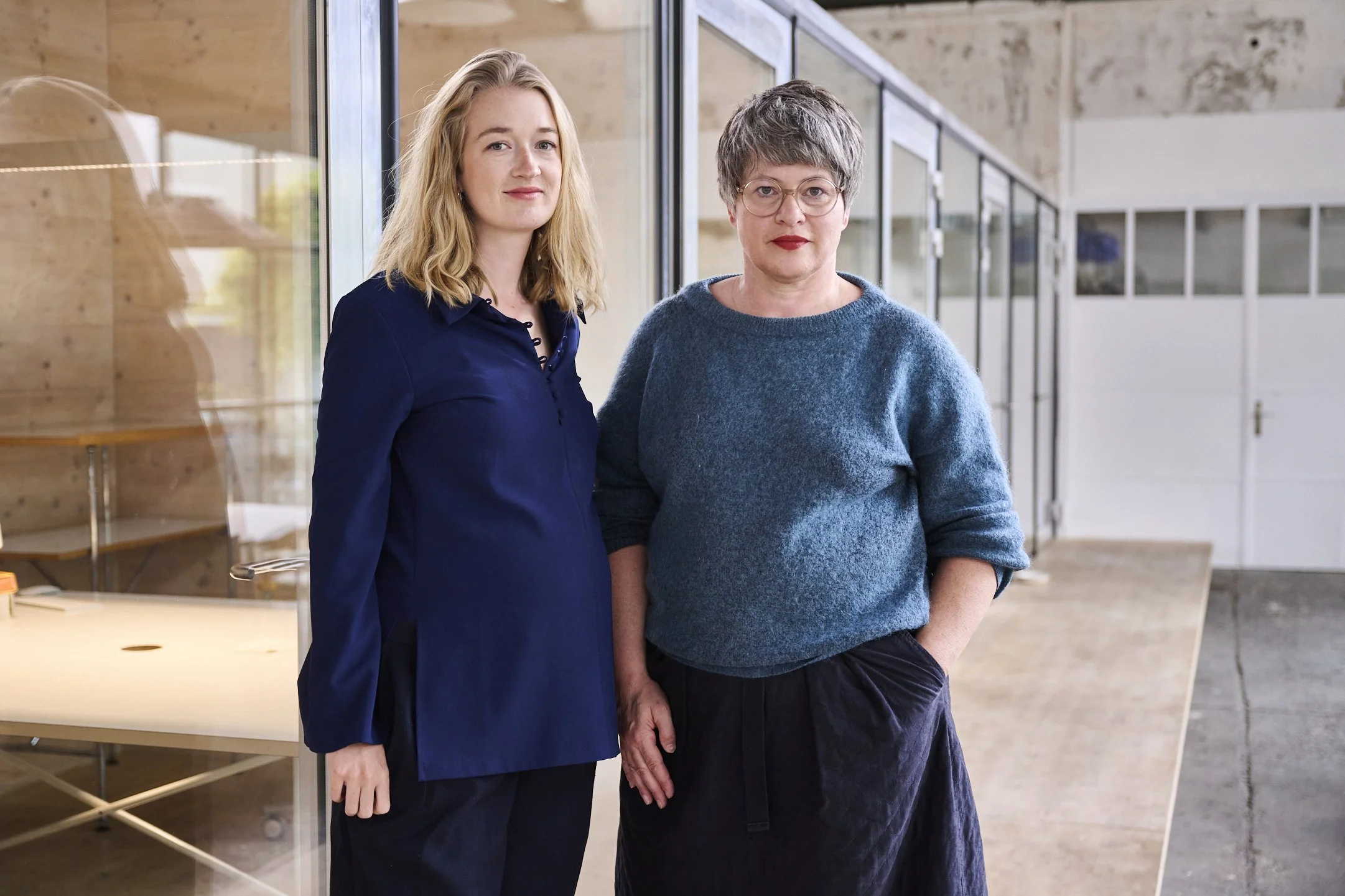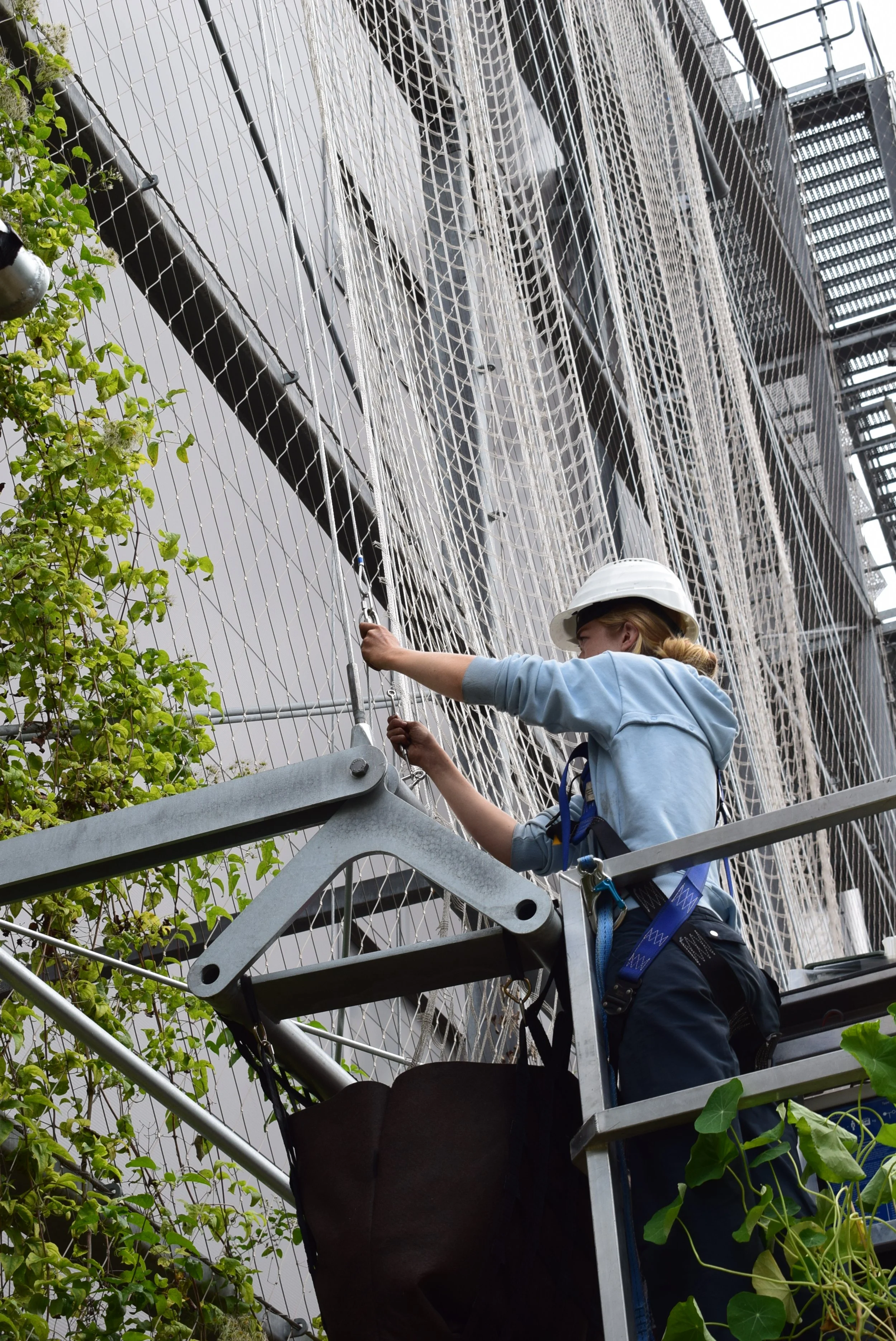OMC°C
Carlotta and Nicola, please introduce yourself:
We are OMC°C, an office for climate cultivation. We, Carlotta Stoll and Nicola Stattmann, are two product designers who - together with an interdisciplinary team of experts in botany, architecture, design, construction, and research - have been developing an innovative system for greening public spaces and buildings over the past four years. Innovation, patents, start-up life, business, politics – we’ve experienced it all.
© Team OMC°C
#1 How would you describe your greening system VERD° — what is its core idea, and what makes it different from conventional façade or planting systems?
Our VERD° System works with annual climbing plants instead of perennials. This is a significant difference to other greening systems in that annual plants do not require a root space of at least 80 cm deep as perennials do. Our plants grow in containers which also works where the ground is sealed. In addition, the climbing plants we use grow very fast - in only 10-12 weeks they will cover nets measuring 2.5x10 meters. Right from the first summer on, they develop as much shade and biomass for evaporation and cooling as ‘traditional’ plants after 3-4 years.
For our façade system, we span wire ropes in front of the building, on which we hoist nets, made of natural fibres. This is a comparatively lightweight and minimal construction with few points of contact with the façade. In the summer, our system provides shade on a large scale for façades and even windows, in autumn the biomass is harvested – and in the winter there are no plants so that the sun can bring light and warmth into the building.
Annual plants consist exclusively of young, water-bearing shoots that will not become woody so that there is no lignification over the years. This is a great advantage: there are no fire loads, no unpredictable weight loads and there is no need for costly annual pruning by arborists.
Our system with annual climbing plants is light, easy to mount and maintain, uncomplicated and efficient.




© Ingmar Kurth
#2 The modularity of your product suggests adaptability. How can it respond to different spatial, climatic, and cultural contexts across various cities or regions?
The VERD° system is indeed modular by design. Natural fibre nets, wire ropes, planters, substrate as well as the façade-bound and free-standing structures can be manufactured serially and in part also regionally and then assembled. Irrigation is fully automatic and can be adjusted according to the climate zone. At this point, we are working with plants that are adapted to the climatic conditions of the Mediterranean region and therefore also grow well in our overheated city centres. From the outset, we have planned every component in such a way that we can adapt our system to a wide variety of locations, uses and requirements. Our climbing plants provide shade for residential buildings, industrial facilities, nurseries, schools and public spaces - all the spaces where shade and freshness are needed urgently and quickly.
#3 Co-creation and collaboration appear central to your practice. How do you involve partners, clients, or even local residents in shaping and implementing your system?
Exciting and, above all, relevant topics such as greening, shade, cooling, climate resilience, heat islands, health – the topics we address with urban greening – are not only of interest to us, but also to politicians, researchers, innovators and universities. That is why it was surprisingly easy to approach people and companies to find out whether they would be willing to collaborate on our concept and subsequently on the production and implementation. We found that doors are wide open for new solutions that provide countermeasures to climate change and strengthen the climate resilience of cities.
We have brought together an interdisciplinary network of people, companies, universities and politicians who contribute their know-how to this project. By bringing in everyone's expertise, working out requirements and possibilities simultaneously and jointly, solutions can emerge that are truly innovative and surpass themselves. Interdisciplinary work means that solutions can be developed very quickly, complex issues be worked through and results be verified and demonstrated which will inspire experts and members of the community alike . This is really stimulating and joyful for all all concerned.
© Team OMC°C
#4 What were the biggest challenges in developing a product that is both structurally functional and ecologically sensitive — and how did you navigate them?
In our opinion, product development should always be guided by the following criteria: functional, useful, ecological, viable, minimally invasive, relevant but also fascinating - we then speak of human-, eco- and, more recently, planet-centred design. In order to develop such solutions, requirements must be researched, analysed, considered and developed in great detail. This calls for profound expertise and an intense development process. We believe that such a process can only be navigated in a good team which is open to all possibilities and facts and, above all, driven by the desire to find the one optimal solution. This process needs to be initially open-ended and then developed and implemented with maximum consistency. Only then something can be created which does not harm the planet, biodiversity and humanity – or, better still, do some good.
#5 The plant selection was developed over a long period in collaboration with a gardener. What qualities make these specific species particularly well-suited for your system — both in terms of aesthetics and ecological performance?
We demand quite a lot from our climbing plants. They should grow as quickly as possible, produce a lot of biomass, have the largest possible yet stable leaves, be resistant, tolerate strong sunlight but also wind and be absolutely non-toxic and non-allergenic for use in nurseries and schools. In addition, the flowers should contain as much pollen and nectar as possible to serve as a food source for insects. We also have a night-flowering plant, which is particularly beneficial for moths.
In collaboration with the plant expert Dieter Gaissmayer and the entomologists at the Senckenberg Gesellschaft für Naturkunde in Frankfurt, we have arrived at a combination of 25 plants that can accomplish all of this. They bloom in different colours throughout the summer and form a very diverse, dense, and colourful network of plants that move in the wind and provide shade, a wonderful place to stay and lots of joy.
© Ingmar Kurth
#6 How do you envision the long-term impact of your system — not only in terms of vegetation growth, but also in shifting perceptions of how architecture / design and ecology can coexist?
In the future, cities and their inhabitants will need more and more shady spaces – to enable them to get to work or school and generally to spend time in public. Buildings are needed, that are cooled without using energy-intensive technology. City dwellers are well familiar with the issue of overheating – when being active becomes almost impossible and temperatures threatening. That is why we need so much more green in our cities – everywhere. In urban planning, people are starting to talk about "shade equity", i.e. a right to shade, particularly for neighbourhoods that have been underprivileged in terms of space and green areas.
Greening as a measure to enhance climate resilience is increasingly made obligatory by new communal regulations. Consequently we need to look for the best, most aesthetic, most efficient and overall best solutions for integrating plants into architecture and the built environment. BUT – and this is our recommendation for all architects – it will not work if you plan the architecture first and try to integrate a few plants into your grid, structure, or façade construction afterwards. Please. forget this approach: The plants are the protagonists, and they want to grow from the bottom up with enough space, air, room and water and definitely not be mechanised.
#7 How do you see the role of a designer/architect in today's society?
I believe that we need to assume our responsibility and conduct our research, development, organising, teaching and creating with a planet-centred mindset. As creative people, be it architects, designers or artists, we can use creativity as a tool to rethink, communicate, and implement things in a way that benefits people in terms of health and public good.
For this reason design and architecture should play a major role in the planning of community, living environment and lifestyle. Not dogmatic, not self-indulgent, but maximally responsible and supportive.
© Team OMC°C
#8 How does the environment influence your work?
It completely influences our work and my life. Not in a dogmatic or threatening way - but I am convinced that preserving our environment is absolutely fundamental. The economy, finance, progress, technology, IT - none of this matters if we no longer have a living space and balanced, intact biodiversity. That's why I never see environmental protection as a restriction or a sacrifice, but always as an opportunity for a future worth living.
#9 Three things that inspire you at the moment?
Frankfurt and the Rhine-Main region will be World Design Capital in 2026 and the theme is DESIGN FOR DEMOCRACY. So much is already being discussed, planned, organised, citizens are being involved in a participatory way – I find this incredibly inspiring and I can't wait to see and experience the results in the coming year.
#10 What do you currently read, watch, listen to?
I love the music of Zaho de Sagazan, the last book I read was "Years with Martha" by Martin Kordić, and I was very much impressed by the exhibition "WEtransFORM" currently at the Bundeskunsthalle in Bonn – which covers all the topics discussed here.
... says Nicola as Carlotta has just become a mother and is currently taking care of her little family.
© Team OMC°C
The installation VERD is currently on view as part of the exhibition WEtransFORM at the Bundeskunsthalle in Bonn. The exhibition presents 80 projects that address the challenges of climate change in a wide variety of ways. VERD is one of these projects and is displayed outdoors on the Museum Square.
Links
Instagram: @omcc_office
website: omc-c.com
Photo Credits: © Team OMC°C and © Ingmar Kurth
Interview by Caroline Steffen










